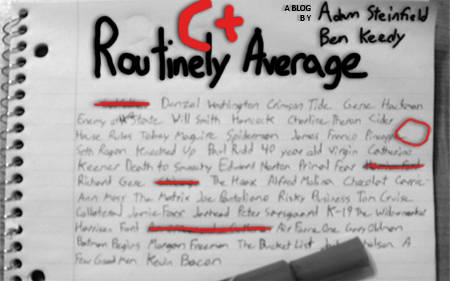
"There is the cinema before Godard and the cinema after Godard."
Arguably the most radical and most prominent of the Nouvelle Vague (French New Wave) filmmakers, Jean-Luc Godard’s greatest talent is undoubtedly for innovation. His unprecedented use of pop culture references, literary and cinematic allusions, eclectic and improvised dialogue, long tracking shots, long takes, jump cuts and other methods of expression revolutionized cinema as we know it. But Godard, who is to receive an honorary Academy Award for lifetime achievement at the next Oscars, is not for every taste. Because he rejects the standard principals of traditional cinema as means to display his originality, his films are sometimes characterized by American cinemagoers as monotonous, infuriating and difficult.
Godard nevertheless clearly illustrates everything there is to know about film theory and cinematic techniques. It is no surprise that he has greatly influenced a number of contemporary directors such as Jonathan Demme, Michel Gondry, Martin Scorsese, Steven Soderbergh and Quentin Tarantino. As a matter of fact, not only did Tarantino name his production company A Band Apart, a play on words of the Godard film Bande à Part (Band of Outsiders), but his first two features, Reservoir Dogs (1992) and Pulp Fiction (1994), are also full with hommages to Bande à Part.
Perhaps one of his "easiest" films, Bande à Part is Godard’s seventh feature, made in 1964. Following up on his groundbreaking classics À bout de souffle (Breathless, 1960), Vivre sa Vie (My Life to Live, 1962) and Le Mépris (Contempt, 1963), Godard pays tribute to the American film noir classics of the 1940s and 1950s in this adaptation of American author Dolores Hitchens’ 1958 novel Fool’s Gold. The film stars Claude Brasseur, Sami Frey, and Godard’s then wife, the beautiful and captivating Anna Karina.
For those who appreciate the director’s unique stylistic approach, Bande à Part is an electrifying caper. It centers on a couple of amateur criminals, Franz (Frey) and Arthur (Brasseur). The two men revere and model themselves on American gangsters. They act out gun battles where Billy the Kid is shot by Sheriff Pat Garrett.

While in English class, Franz meets a young woman, Odile (Karina), who quickly reveals that M. Stolz, her aunt’s mysterious lodger, keeps a large amount of money unlocked in his room. The chance to commit a robbery is too perfect of an opportunity to pass up, so Franz and Arthur plan to steal the money and convince Odile to cooperate. Unfortunately, Arthur's uncle somehow learns of their plot and wants to take over.
The most interesting aspect of Bande à Part is not the story itself but the unpredictability in terms of how the tale is told. Godard pushes the boundaries of what is acceptable in cinema, leading to some surreal moments. The film is not so much about plot or character development, but instead is an expression of the moments in between. The story line is a simple pretext for Godard to demonstrate his cinematographic ingenuity. The characters barely go through any change during the film; the scenes that do not advance the plot are definitely the most appealing and give the film its offbeat charm.
One of these scenes takes place in a diner. Momentarily stuck for words, Odile, Arthur and Franz suggest a minute of silence. “A minute’s silence can be very long,” says Franz. Godard plays a joke on the viewer by eliminating for 36 seconds all the ambient noise, to great comic effect. Shortly after that, the three characters perform a dance routine in the middle of the café (which influenced the dance sequence with Mia Wallace (Uma Thurman) and Vincent Vega (John Travolta) in Pulp Fiction). This time, Godard cuts out the music (but not the background noise) at regular intervals to tell the audience directly what each of them thinks and feels. As the narrator is not one of the characters, this adds a documentary feel to the film.

The dance routine does not push the story forward, it is insignificant to the film as a whole, but it captures a peaceful moment in time. What has happened or will happen is not important; all that matters is the purity of this one perfect instant. By breaking the limitations of realistic structure, Godard effectively reminds us that we are just watching a film, nothing more and nothing less.
Bande à Part is splendid, genuinely brilliant and exceptionally distinct. Its superior artistic quality is as spectacular as it was four decades ago. Godard created a film that has proved to be able to successfully pass the test of time; an influential film to see again and again. A good place to learn how much of a debt modern cinema owes him.
27/30

Great stuff and welcome to the blog Chris. Our foreign movies section has been a tad neglected. I'm definitely adding Bande à Part to the que.
ReplyDeleteI'm ashamed to admit movies in subtitles have never been my thing (nor do I like "other language" dubbed films), so I've missed most of the must-see foreign films. But thanks for including them in the blog - it's good to know why I should make the effort to see them. Nice review.
ReplyDeleteI need to see more Godard. As a classic and the most frequently-cited film of the Nouvelle Vague, I considered À bout de souffle basically obligatory... but was disappointed upon watching it with a less than captivating story and only mildly interesting main characters. In fact, the notorious jump-cutting was only aspect of the film that I really found exceptional (and I learned later that this was not initially planned, but a result of the film being too long and not wanting to cut any scenes). Perhaps, as is often the case, the most famous film is not the best. I'll have to look into Bande à part.
ReplyDelete